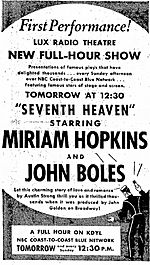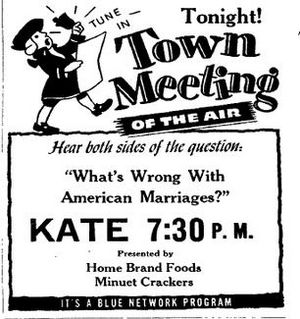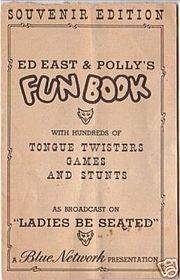Blue Network facts for kids
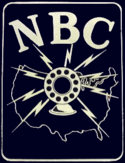 |
|
 |
|
| Type | Radio network |
|---|---|
| Country | |
| Ownership | |
| Owner |
|
|
Key people
|
|
| History | |
| Launch date | January 1, 1927 |
| Replaced |
|
| Closed |
|
| Replaced by | American Broadcasting Company (ABC) |
|
Former names
|
|
| Coverage | |
| Availability | National, through regional affiliates |
The Blue Network was a famous American radio network that broadcast from 1927 to 1945. It started as one of two radio networks owned by the National Broadcasting Company.
In 1942, the Blue Network became independent due to a legal case about fair competition. By 1943, it officially changed its name to the American Broadcasting Company (ABC). However, it continued to work closely with NBC for two more years.
Contents
How the Blue Network Started
The story of the Blue Network began in 1923. That's when the Radio Corporation of America bought a radio station called WJZ in Newark, New Jersey. WJZ then moved to New York City.
When RCA also started WRC in Washington, D.C., in August 1923, the idea of a radio network began to form. These early stations, WJZ, WRC, WBZ, and WGY, were known as the "Radio Group."
Back then, RCA's main competitor was a company called AT&T. AT&T had better ways to send radio signals. This meant RCA had to use telegraph lines, which weren't as good for clear voice broadcasts.
Even so, the WJZ network tried to compete with AT&T's network. For example, both networks sent reporters to cover big events like the 1924 Democratic National Convention. WJZ also claimed to be the first to broadcast educational music, the World Series, and a full opera.
The Network is Created
In 1926, AT&T decided to leave the broadcasting business. This was a big opportunity for RCA. AT&T sold its main station, WEAF, to RCA for a lot of money.
After buying WEAF, RCA created the National Broadcasting Company (NBC) on September 13, 1926. NBC's first broadcast was on November 15, 1926. This marked the start of the NBC Red Network, which mostly aired popular entertainment shows.
On January 1, 1927, the Blue Network officially began. WJZ became its main station. The Blue Network often focused on news, public affairs, and shows that didn't have sponsors.
The names "Red" and "Blue" supposedly came from how the networks were drawn on maps. Red lines showed the WEAF network, and blue lines showed the WJZ network.
How the Network Operated (1927–1941)
Working with the Red Network
The Red and Blue Networks shared engineers and equipment. Sometimes, they even broadcast the same events. For example, in 1927, both networks covered Charles Lindbergh's return to America after his famous flight. They also broadcast the second Dempsey–Tunney boxing match.
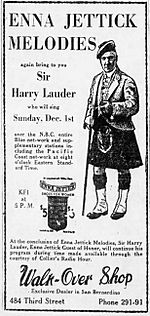
Even in 1929, famous singer Sir Harry Lauder appeared on a show that was sent across the country. It started in Los Angeles but was sent out by WJZ, the Blue Network's main station. Sometimes, Red Network stations also joined in.
As late as 1939, even though NBC was trying to make the Red and Blue networks seem different, they still did special joint broadcasts.
The Blue Network's Role in the 1930s
Even though the Blue Network usually didn't get the most popular shows, it did broadcast Amos 'n Andy when it was incredibly popular. More than half of all radio listeners tuned in to that show!
Often, the Blue Network was like a "farm team" for the Red Network. Many popular shows like Fibber McGee and Molly and Information, Please! started on the Blue Network. Then, they moved to the Red Network to reach bigger audiences.
Some shows only stayed on NBC Blue for a short time before moving to other networks, like the Lux Radio Theatre.
In the late 1920s and early 1930s, the Blue Network was also known for its children's programs. Some books were even published with stories from these shows. This shows that the Blue Network had its own clear identity by 1929.
Challenges for the Blue Network
Some stations were not happy with how NBC managed the Blue Network. They felt it was neglected compared to the Red Network. For example, a station in Syracuse, New York, complained in 1934 about this neglect.
Another issue was that the Blue Network was much smaller than its rivals. In 1937, it had only 33 stations. By comparison, Mutual had 107 stations and CBS had 114 in 1938. This meant the Blue Network couldn't reach as many homes, and its income was falling.
The Network's Image
The Blue Network became known for more serious and cultural programs. It was the original home of the NBC Symphony Orchestra broadcasts, led by the famous conductor Arturo Toscanini.
Another long-running show was America's Town Meeting of the Air, which discussed current events. News programs by Lowell Thomas and Walter Winchell were also on the Blue Network. These were its most popular shows in the late 1930s and early 1940s.
The Metropolitan Opera radio broadcasts were also a "crown jewel" of NBC Blue. A 1937 pamphlet said these broadcasts brought grand opera to the entire nation. It noted that 78 stations broadcast these performances, reaching listeners across the country.
For many years, the Red and Blue networks were not very different. They shared support staff, and stations often switched between them. However, when the Federal Communications Commission (FCC) started looking into how networks operated, NBC began to make the Blue Network seem more distinct. They wanted it to be known as the network for high-quality and public affairs programs.
NBC also started working hard to expand the Blue Network. It grew from 33 stations in 1937 to 92 stations by January 1941.
Programs (1935–1941)
The Blue Network's programming slowly changed. For example, famous actress Helen Hayes did several dramatic series and appearances on NBC Blue.
Time magazine in 1938 showed the kinds of programs the Blue Network carried. These included speeches by important government officials, championship boxing matches, and classical opera. It also broadcast the Army–Navy football game and the NBC Symphony Orchestra. America's Town Meeting of the Air often featured debates on important topics.
The Cavalcade of America was another high-profile show on the Blue Network. It told dramatic stories about American history. This show had high quality, using famous actors and writers.
On December 7, 1941, the day of the Japanese attack on Pearl Harbor, NBC Blue was broadcasting a play. Later, its broadcasts were interrupted by news reports. It also carried regular shows by Drew Pearson and Eleanor Roosevelt, followed by a news roundup. The popular mystery series Inner Sanctum and Walter Winchell's show were also on the Blue Network that night.
Idea to Sell the Network
In the late 1930s, NBC thought about selling the Blue Network. David Sarnoff, the head of RCA, was involved in these talks. A publication from 1943 mentioned that as early as 1932, some NBC leaders believed the Blue Network would do better if it were independent.
Becoming Independent (1940–1943)
FCC's First Steps
In the 1930s, some people accused NBC and CBS of unfair business practices. They said the networks controlled too much talent and had strict contracts with their affiliated stations.
In May 1940, after a three-year investigation, the Federal Communications Commission (FCC) criticized NBC and CBS. The FCC suggested that each network should only have one affiliated station in each city. This would directly affect NBC, which owned two networks. In May 1941, the FCC made rules to break up what it saw as radio monopolies. One rule specifically stopped a network from owning more than one broadcasting system.
Lawsuits Against NBC
In December 1941, the U.S. Department of Justice filed a lawsuit against NBC and CBS. They wanted to change how the networks operated. Another network, Mutual, also filed a lawsuit against NBC.
While these lawsuits were ongoing, NBC began to formally separate the Red and Blue Networks. This process started in 1939 with separate sales teams. On January 8, 1942, NBC created a separate company for the Blue Network, called "Blue Network Company, Inc." From this point, even though NBC still owned it, the Blue Network was mostly a separate entity. NBC Red then became known simply as NBC.

In June 1942, the Supreme Court said the FCC had the right to make rules about radio networks. On May 10, 1943, the Supreme Court again upheld the FCC's power to regulate radio. This decision pushed NBC to sell the Blue Network.
The Sale of the Network
Many companies were interested in buying the Blue Network. The bidding quickly went up to $7.8 million.
On July 30, 1943, RCA announced the sale of the network to American Broadcasting System, Inc. This company was controlled by Edward J. Noble, a businessman known for Life Savers candy. The price was $8 million. The sale still needed approval from the FCC.
FCC Hearings
One big issue during the sale was the Blue Network's policy on "controversial" topics. The network refused to sell airtime to groups like labor organizations. However, it would give them free airtime if the other side also had a chance to speak.
During the FCC hearings, Chairman James L. Fly strongly criticized this policy. He said it was like "chasing would-be purchasers from the front of the shop, but directing them to the back door for a handout." Mark Woods, the head of the Blue Network, defended the policy.
When Edward J. Noble testified, he was questioned about this policy. He promised that the Blue Network would consider all requests for broadcasting time with "an open mind." This response seemed to satisfy the FCC.
The FCC approved the sale on October 12, 1943. Noble's company acquired WJZ, other stations in Chicago and San Francisco, and the network's system of affiliated stations.
Lawsuits End
After the sale, the Department of Justice dropped its lawsuits against NBC and CBS. Mutual also dropped its lawsuits.
Changes (1943–1945)
After the sale, Mark Woods, the head of the Blue Network, worked to make it more competitive. He wanted it to be as successful as NBC and CBS.
Money and Ownership
Edward Noble brought in new investors to help the network. In December 1943, he sold parts of the company to Time Inc. and advertising executive Chester J. LaRoche.
Programs
From 1943 to 1945, the Blue Network still used many of NBC's broadcasting facilities, including studios in New York and Los Angeles.
The network worked to keep its best programs and make improvements. While it lost some shows to NBC, like Quiz Kids and the NBC Symphony Orchestra, it kept popular ones. For example, the Jergens Journal with Walter Winchell was very successful. The Blue Network also kept the rights to broadcast the Metropolitan Opera radio broadcasts.
The Blue Network also tried new things. On Christmas Day 1942, the Coca-Cola Company sponsored an all-day broadcast called "Victory Parade's Christmas Party of Spotlight Bands." In 1943, they hired famous bandleader Paul Rodgers to improve their music programs.
News remained very important for the network. Raymond Swing even won an award for his news commentary in 1944. Famous news commentators like Walter Winchell, Lowell Thomas, and Drew Pearson were part of the Blue Network's news team.
Blue Network Shows
The Blue Network tried to create new and exciting shows to compete with other networks.
One special broadcast was a two-hour show on Christmas Day 1944, called "Christmas on the Blue." It featured many stars and even included overseas servicemen sending greetings to their families.
Another interesting show was Nitwit Court. It was a comedy show where a host would pose problems to a funny jury. The jury members included famous voice actors like Mel Blanc.
More Stations Join
Getting more stations to join the network was very important. In January 1942, the network had 116 stations. By June 1943, it had 155 stations. This helped the Blue Network reach more radio homes across the United States. The FCC's new rules made it easier for the Blue Network to gain new stations, even some from its rival, Mutual.
Changing the Name
A big goal for the Blue Network was to create a new identity. In December 1944, the FCC approved the transfer of the Blue Network's licenses to the American Broadcasting Company.
Starting January 22, 1945, the network's announcements changed to "The Blue Network of the American Broadcasting Company." On June 15, 1945, the Blue Network officially changed its name to the American Broadcasting Company (ABC). They even bought out other companies that used the name "ABC" to make sure they were the only ones. From June 1945 onward, the company has been known as ABC.
Television
During World War II, building new television stations was put on hold. ABC was also slow to get into television broadcasting. However, it did get approval to build five TV stations. The first, WJZ-TV in New York, was finished in 1948. Other stations followed in Chicago, Detroit, San Francisco, and Los Angeles.
Before these stations were built, ABC had to rent time and studios from other TV stations. The Blue Network did experiment with television before it officially became ABC in June 1945. For example, a script still exists for a February 25, 1945, broadcast of Ladies Be Seated, a popular radio game show. This was a local TV broadcast, but the opening title card said, "The Blue Network of the American Broadcasting Company."
Blue Network Stations
The Blue Network had different groups of stations across the country. The main group was called "Basic Blue" and covered the Northeast and parts of the Midwest. There were also groups for the Southern, Rocky Mountain, Pacific Coast, and Southwestern regions.
Here are some of the Blue Network stations that participated in a broadcast on April 9, 1939:
|
|
|
|
|
|
Other Blue Network stations in 1939 included WABY (Albany, New York), WJTN (Jamestown, New York), WRTD (Richmond, Virginia), WLEU (Erie, Pennsylvania), CFCF (Montreal, Quebec), and WMFF in Plattsburgh, New York.
Images for kids
-
Jessie Royce Landis (left) and Celeste Holm (right) with a Blue Network microphone in 1943.
See also
 In Spanish: Blue Network para niños
In Spanish: Blue Network para niños
- Metropolitan Opera radio broadcasts


